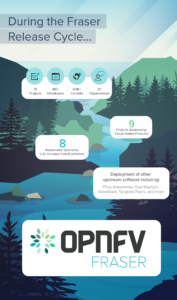With even more mature cloud native integration, better testing, additional features, and expanded CI/CD infrastructure, OPNFV Fraser builds ecosystem bridge to cloud providers
San Francisco — May 1, 2018 — The OPNFV Project, an open source project within The Linux Foundation that facilitates the development and evolution of Network Functions Virtualization (NFV) components across various open source ecosystems through reference platform development, integration, deployment, and testing, today announced the availability of the sixth OPNFV platform release, OPNFV Fraser. Making the mission of OPNFV more operationally relevant, Fraser advances the state of NFV around cloud native applications and new upstream project integration while continuing end user support as they deploy and test virtualized networks.
By increasing support for cloud native applications and providing access to readily deployed NFV infrastructure on demand, OPNFV provides the platform and tooling required by developers with whom end users are actively collaborating to validate, integrate, onboard, and test NFVI, VIM, VNFs, and network services. With a new level of maturity that brings the industry even closer to true cloud native integration that can be leveraged by cloud providers, Fraser has deepened its testing capabilities around functional, performance, stress, and benchmark testing. The release also brings new carrier-grade features around monitoring, service assurance, networking, and dataplane acceleration. With these updates, Fraser strengthens the project’s position as the nexus point for collaboration across networking ecosystems.
“Since inception, OPNFV has been the place for industry collaboration with upstream communities, which has grown even more with the Fraser release,” said Heather Kirksey, VP, Community and Ecosystem Development, The Linux Foundation. “With more mature cloud native integration and expanded testing and collaboration, OPNFV delivers the tools needed for end users to validate and test new network services.”
Key updates in OPNFV Fraser include:
- Advancing the support for cloud native NFV. Fraser expanded cloud native NFV capabilities in nine different projects, more than doubled the number of supported Kubernetes-based scenarios, deployed two containerized VNFs, and integrated additional cloud native technologies from the Cloud Native Computing Foundation (CNCF) relating to service mesh (Istio/Envoy), logging (fluentd), tracing (opentracing with Jaeger), monitoring (Prometheus), and package management (gRPC). These updates move the cloud native capabilities from basic container orchestration to include operational needs for cloud native applications. Additionally, the FastDataStacks project takes advantage of FD.io work to incorporate the VPP dataplane into Kubernetes networking capabilities to enable cloud native network-centric services.
- More mature testing. OPNFV continues to focus on the real-world deployment needs of service providers by expanding test case coverage and scope. Testing projects in Fraser see a robust increase in test cases. Functest, the OPNFV functional testing project, now permits use of its framework with other open source projects such as ONAP. This avoids duplication, reduces VM size, and accelerates the creation of additional test cases. Functest also added test cases to cover Kubernetes and Clover and made it easier and faster to run functional tests. Also in support of real-world needs, performance test projects extended the Day 0 performance testing to long-running performance testing as Day N operational issues become more real for service providers.
- Continuous Integration (CI) updates enable increased community hardware utilization, which in turns speeds up the testing process. Fraser includes the latest versions of upstream projects and advanced dynamic CI with the introduction of metadata descriptor specifications for Scenarios, PODs, and installers that will make hardware allocation for scenarios dynamic and automated. The XCI cross-community project made additional cloud-native strides by initiating CI/CD integration work with the CNCF Cloud CI project.
- New carrier-grade features are added, specifically in the areas of monitoring, service assurance, networking, and dataplane acceleration. Specific new features include:
-
- The Doctor project, in conjunction with OpenStack, whose collaboration was instrumental in achieving this milestone, introduced an infrastructure maintenance use case for zero VNF downtime. Similarly, Barometer continued to expand the monitored items list and plugin support. The Calipso project added support for Kubernetes and physical/physical-virtual switch connections across heterogeneous environments.
- The SFC, SDNVPN, FastDataStack, and Parser projects added new features around networking and dataplane acceleration.
- The IPv6 project now supports clustering, simplifying network configuration, and is exploring IPv6 container networking.
Supporting Operator Deployments
Orange and China Mobile have used OPNFV continuous integration (CI) pipeline and testing projects to create an NFV onboarding framework within their organizations. Orange uses OPNFV for NFVI and VIM validation, VNF onboarding and validation, and network service onboarding. China Mobile uses OPNFV for their Telecom Integrated Cloud (TIC) to continuously integrate, onboard and test NFVI, VIM and VNFs; and full network service onboarding and testing based on OPNFV is on their roadmap.
“Orange sees OPNFV as the right vehicle to create and end-to-end solution to certify VNFs, NFVI reference architecture, and integration with ONAP,” said Jehanne Savi, Executive Leader of the AII-IP and On-demand Networks Programmes, Orange.
What’s Next
The fifth OPNFV Plugfest will be co-located with ETSI at their location in Sophia Antipolis, France on June 4-8, 2018. Testing will include ETSI test cases and will focus on interoperability of the OPNFV platform in deployment, network integration, VNF applications, and more. Both OPNFV members and non-members are welcome to attend.
The recently announced OPNFV Verification Program (OVP) had four graduates in its first iteration (Huawei, Nokia, Wind River, ZTE) and is recruiting more vendors and network operators to participate in the next version of the test suite and program.
The virtual central office (VCO) demo is expanding into residential services with a virtualized Mobile Network use case, including vRAN for the LTE RAN as well as vEPC for a minimum viable mobile access network configuration. The demo will be featured at the Open Networking Summit Europe event, September 25-27 in Amsterdam.
The seventh OPNFV release, Gambia, due out end-of-year or early 2019, will include a slew of new projects. Areas of focus are expected to featureinclude: C-RAN (cloud radio area network), AUTO (ONAP automated OPNFV), eEdge cloud, and Capstone (certificate management service), among others.
More information about OPNFV Fraser is available at https://www.opnfv.org/software/downloads.
About The Linux Foundation
The Linux Foundation is the organization of choice for the world’s top developers and companies to build ecosystems that accelerate open technology development and commercial adoption. Together with the worldwide open source community, it is solving the hardest technology problems by creating the largest shared technology investment in history. Founded in 2000, The Linux Foundation today provides tools, training and events to scale any open source project, which together deliver an economic impact not achievable by any one company. More information can be found at www.linuxfoundation.org.
###
The Linux Foundation has registered trademarks and uses trademarks. For a list of trademarks of The Linux Foundation, please see our trademark usage page: https://www.linuxfoundation.org/trademark-usage. Linux is a registered trademark of Linus Torvalds.
 Long ago, networks comprised discrete elements with dedicated hardware running software that performed a function. Only one application ran on a single piece of hardware, namely the network element itself. The application had perfect knowledge of the hardware environment on which it was running.
Long ago, networks comprised discrete elements with dedicated hardware running software that performed a function. Only one application ran on a single piece of hardware, namely the network element itself. The application had perfect knowledge of the hardware environment on which it was running.
 Fraser Highlights
Fraser Highlights